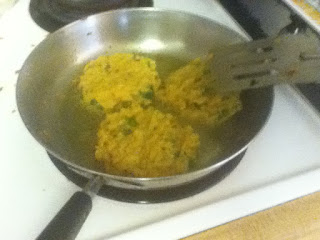
Risotto recipes are easy to find-- google it, or open an italian cookbook (not all will have risotto, but many do). Even the bag of rice I bought had a basic risotto recipe printed on it. Generally, a risotto is made by sautéing some onions, toasting the rice, adding some wine, then gradually adding hot broth while stirring, stirring, and stirring. The stirring is key, and my copy of Modernist Cuisine at Home (I freely admit to name-dropping) tells us why: what makes risotto so wonderfully creamy is starch. Arborio rice (and others suitable for risotto) are especially high in amylopectin, a type of starch. Amylopectin is the branched starch that
your body easily breaks down (think of the starch molecule as a stick you 10 other people want to break into toothpicks. The more branches it has, the more places there are for you to grab on and start breaking.) The problem is that starch is kept inside the cell (you know, where the plant can use it). When you expose the rice to hot liquids, some of the starch can be released, but the majority of it is released by mechanically whacking those cell walls--by stirring. So the more you stir, the more cells walls are broken, and the more walls are broken, the more starch you set free, and the creamier your risotto becomes.
I used another recipe from Rachael Ray's Big Orange Book, mostly because I had wanted to try it for a long time, but also because I had leftover beets hanging out in my kitchen: Beet Risotto.
1) Heat an oven to 400 degrees (Fahrenheit). Place 4 medium beets, scrubbed and with the ends trimmed, on a large piece of aluminum foil. Drizzle oil over the beets, and season with salt and pepper. Fold up the foil and place it in the oven, roasting the beets for about 45 minutes until they are tender. (You could also do this on a grill, if you prefer, or even a campfire, though I don't know why you would. It just occurred to me that I've cooked veggies over a fire this way before.) Once the beets are soft, let them cool, then throw them in the food processor/ blender and puree them. Do be careful. It will stain.
2) In the meantime, heat up 4 cups vegetable stock with 2 cups of water added-- bring it to a boil, then just keep it warm.
 |
| Toasting the rice. Note: this pan was NOT big enough to finish the recipe. |
4) Serve topped with extra Parmigiano and/or feta. Rachael Ray serves it over the greens from the beets, but my beets were old and didn't have nice greens. I would have used spinach, if I had some, or possibly kale, which I've never eaten but would look pretty. (dark red, dark green...)
Rachael says it makes 4 servings. My family of 5 was given about half of what was made, and thought it was an awful lot.
































